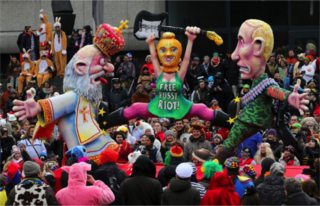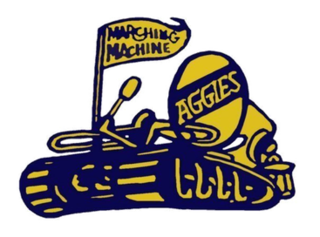
A drill team can be one of four different entities:
- A military drill team is a marching unit that performs routines based on military foot or exhibition drills. Military drill teams perform either armed or unarmed.
- A dance drill team creates routines based on precision dance movements rather than military drill. These teams usually do not carry anything, but may use props in field production numbers. They may perform to recorded music, or the live music of an accompanying marching band.
- A team that execute routines carrying either one or multiple flags or pom-poms. This team's movements are also based in dance and may also have a heavy influence of gymnastics as well. These teams also may perform to music, either live or recorded.
- A team that is mounted or advances some type of mobile object. May also include teams of dogs and handlers.

Color guards or flag corps are teams of performers who perform choreographed dances and routines with various equipment to enhance and interpret the music of a marching band or drum and bugle corps show. Color guard teams can be found in American colleges, universities, high schools, middle schools and independent drum corps. They use various equipment including flags, non-functioning rifles, and sabres, along with other props. Most Color Guard groups are of mixed gender but some may also be single gender.

Baton twirling involves using the body to spin a metal rod in a coordinated routine. It is similar to rhythmic gymnastics or color guard.

The Purdue "All-American" Marching Band is the marching band of Purdue University and the main source of auxiliary entertainment for Purdue Boilermakers football games. The AAMB is also the official band of the Indianapolis 500 race, having held the position since 1919. The band has grown from an original 5 members to 389 members. The three most distinctive features of the AAMB are the Purdue Big Bass Drum, the Purdue Golden Girl featured twirler, and the "Block P," the first marching band field formation created in 1907.
Freddie Letuli,, originated the fire knife dance in 1946 at the Golden Gate Park in San Francisco, previously dancing in Hawaii and Los Angeles with two knives. Along with performing, Freddie was also the teacher to the early fire knife dancers.

Twirling is a form of object manipulation where an object is twirled by one or two hands, the fingers or by other parts of the body. Twirling practice manipulates the object in circular or near circular patterns. It can also be done indirectly by the use of another object or objects as in the case of devil stick manipulation where handsticks are used. Twirling is performed as a hobby, sport, exercise or performance.

The Hawkeye Marching Band is the marching band for the University of Iowa. The band performs at all home Hawkeye football games at Kinnick Stadium in addition to other events. It is the largest and most visible musical ensemble at the university. The band was founded in 1881 as a military band, giving membership to both music students and members of the military. In 1990, the band was awarded the Louis Sudler Intercollegiate Marching Band Trophy, generally considered to be the most prestigious honor a collegiate marching band can receive.

The fire knife is a traditional Samoan cultural implement that is used in ceremonial dances. It was originally composed of a machete wrapped in towels on both ends with a portion of the blade exposed in the middle. Tribal performers of fire knife dancing dance while twirling the knife and doing other acrobatic stunts. The towels are set afire during the dances, hence the name.
Pep flags, also known as flaggies, short flags, small flags, or twirl flags, is the performing art of twirling one or two flag(s) as part of a choreographed routine. In the early 21st century, some school flag squads have implemented a third or even fourth flag in routines. This performing art is mainly prominent in Southern California high schools. It is mainly in high schools but a few are in elementary, middle school, and college/university levels.
National Football League Cheerleading or simply NFL Cheerleading, is a group of professional cheerleading organizations in the United States. 25 of the 32 NFL teams include a cheerleading squad in their franchise. Cheerleaders are a popular attraction that can give a team more coverage/airtime, popular local support, and increased media image. In 1954, the Baltimore Colts became the first NFL team to have cheerleaders. They were part of Baltimore's Marching Colts.
The University of Pittsburgh Varsity Marching Band, or Pitt Band, is the college marching band at the University of Pittsburgh. The band numbers over 300 students consisting of instrumentalists, a majorette squad known as the Golden Girls, a color guard, and the drumline. The band was founded in 1911 and has won numerous awards over the years. All members of the band must pass an audition in order to join. The band is currently housed in Trees Hall; however, in 2020, the Pitt Athletic Department announced its "Victory Heights" initiative, part of the campus master plan which includes a new marching band facility slated to open in 2024.

Marching Mizzou, M2, or The Big 'M' of the Midwest is the performing marching band for the University of Missouri, founded in 1885 as a college military band. Originally consisting of only 12 members, it is now the largest student organization on the MU campus, drawing students from nearly every major. Marching Mizzou performs at all home football games of the Missouri Tigers football team, in addition to other university events; and expanded Mini Mizzou travels to two away games per season, while the entire band regularly follows the team to conference championship games and bowl games. Marching Mizzou's signature drill "Flip Tigers" has been a well-known tradition of its pre-game show since 1960. It is instructed by University of Missouri School of Music faculty.

The Saintsations are a cheerleading and dance squad that performs at New Orleans Saints football games. In addition, they are ambassadors for the organization and can be seen participating in various community events & projects.

Several Green Bay Packers cheerleading squads have performed in Green Bay Packers' history. The Packers became one of the first professional football teams to have a cheerleading squad, having first used cheerleaders in 1931. The squad performed for 57 years under three separate names. In 1988, it was decided that the team would cease having a professional squad cheer for them. Since 1988, the team uses collegiate squads in a limited role to cheer during home games.
J-Setting is a style of dance popularized by the Prancing J-Settes, the popular collegiate women's danceline of Jackson State University's Sonic Boom of the South marching band. It originated in the late 1970s from African-Americans in the Jackson, Mississippi, area of the United States.

The Denver Broncos Cheerleaders are the official cheerleading squad of the Denver Broncos. In addition to performing on game days, the Denver Broncos Cheerleaders annually commit close to 1,000 hours to various charities and events in Denver and the state of Colorado.

Carnival in the Netherlands is a festival held mainly in the Southern and Eastern regions of the Netherlands with an emphasis on role-reversal and the suspension of social norms, as part of celebrations of Carnival. The feast was assimilated by the Catholic Church, taking elements from ancient pagan spring festivals and is celebrated in the three days preceding the Christian holidays of Ash Wednesday and Lent.

The Blue and Gold Marching Machine is the official marching band of North Carolina A&T State University. The Blue and Gold Marching Machine performs pre-game and halftime shows at all North Carolina A&T Aggies football home games and travels to most away games.

The Marching Scarlet Knights is the marching band of Rutgers University. The band was founded in 1915 as a small military band, and since then has grown into a 255-member athletic band for the university. The Marching Scarlet Knights performs at all home Rutgers Scarlet Knights football games. The band also travels to select regular season and post season football games.

Marawa, stage name Marawa the Amazing, is an Australian-born performer, athlete, and author. She has held 12 different Guinness World Records, but is best known for holding the record for the most simultaneous twirling hula hoops, having spun 200.


















